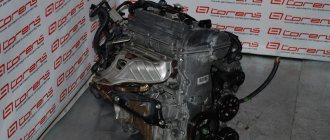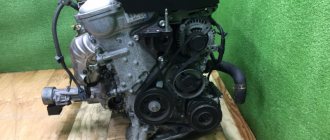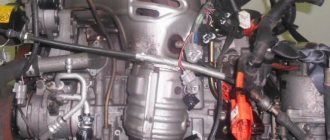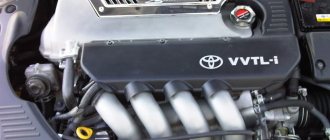Technical data
The four-stroke gasoline engine of the Japanese manufacturer Kamigo Plant has been produced since 1999. Production of the successful 2nz fe power unit continues today.
The material used to make the BC is a particularly durable aluminum alloy. The cylinder head is made of aluminum.
The four cylinders are located in one row in the engine compartment of the internal combustion engine and have a transverse arrangement.
- ICE power system, electronic sequential injection SFI injector.
- The 2nz fe timing system is DOHS, equipped with two gas camshafts and 16 valves.
- The timing drive is made of a homogeneous chain, with a pitch of 8 mm.
- The piston stroke length is less than the cylinder diameter: 73.5 and 75 mm, respectively. The compression ratio of the combustion chamber is 10.5:1.
- The exact volume of the power unit is 1298 cm3.
- Engine power at 6000 rpm is 84 hp. Peak torque at 4400 rpm, 121 Nm.
- European environmental compliance standards for emissions of harmful substances: Euro 4, Euro 5. The weight of the power unit is 112 kg.
- Normal temperature for internal combustion engines is 90C.
Fuel consumption
Fuel consumption during city driving is 7.2 liters, on the highway 5.3 liters, total fuel consumption is 6 liters per 100 km, mileage.
Oil consumption and oil volume
The permissible consumption of motor lubricant is 1 liter per 1000 km. Oil used: 5W30, 10W30. The oil volume in the engine is 3.7 liters. You need to change the engine lubricant after a mileage of 10 thousand km.
Engine life
According to the manufacturer, the operating life of the engine is 200 thousand km. Real mileage with careful operation and proper maintenance can reach 500 thousand km.
Where was the engine installed?
The 2NZ-FE unit, due to its minimal volume, is used in the following vehicles:
- funcargo;
- Vios;
- Yaris, Echo, Vitz;
- Porte;
- Platz;
- Belta;
- Corolla E140 in Pakistan;
- Toyota bB;
- Ist.
All cars are small, so using a small unit made sense.
The use of engines with low fuel consumption attracts attention with their potential. Any engine is the most significant part, and the ability to overhaul or modernize it is very important. The 2NZ FE power plant is a fairly economical system, its fuel consumption does not exceed 7.2 liters. Although such indicators were achieved by reducing capital costs, the service life of this engine exceeds 200 thousand km.
Decoding the power unit markings
Japanese-made power units are marked according to a special formula. Knowing which symbols represent what, you can easily obtain extensive information about the engine.
The general form of the formula is × ×× ××× where:
- In the first place there is always a number indicating the generation of a given engine family. Here this number 2 means the second generation;
- in the next two places the Latin letters indicate the engine family, here it is called NZ;
- the next symbols indicate the technical features of the power unit:
- F - indicates the presence of a DOHS timing mechanism, with two camshafts and 16 valves
- The letter E indicates that it is equipped with SFI electronic injection.
Other designations for power plant features may also be used.
Brief history of the 2NZ FE engine
The engine in question was the latest development of the NZ family of power units. The trend toward fuel-efficient engines emerged in the late 90s, when gasoline prices rose sharply. Small-displacement, economical engines turned out to be just the thing. Serial production of the 2NZ FE began in early 1999, and although modifications of the nz series of internal combustion engines are no longer being designed, the engine in question is being successfully produced today.
Yamaha's development is now somewhat outdated, but it has its advantages and disadvantages. And the efficiency of this engine is impeccable and undeniable.
Description of the power unit
The 2NZ-FE is very similar to its more powerful brother the 1NZ FE in many ways. To obtain a more economical power plant, the engine size was reduced. This was achieved by reducing the piston stroke. On the motor in question it became 73.5 mm, and on the 1nz it was 84.7 mm. To accommodate the smaller crankshaft, the height of the cylinder block was reduced.
To achieve the desired dimensions, the angle of the exhaust and intake valves was changed, now it is 33.5 degrees. The engine began to look more compact. ShPG has undergone changes. The result is an economical, environmentally friendly engine with a displacement of 1.3 liters for small, compact cars.
In 2004, the 2nz was seriously modernized, the need for constant adjustment of thermal clearances in the valves was eliminated, and the engine received the long-awaited hydraulic compensators. Instead of a mechanical throttle, the engine was equipped with ETCS-i - an electronic throttle.
In all other respects these are identical engines. The gas distribution mechanism is the same - with the same problems. They even upgraded and received expansion joints in the same year. On these engines, the timing drive mechanism can cause many problems. This applies to the single row chain, guide and tensioner. Despite the declared resource, cases of chain breakage are possible after 100 thousand km. This happens after the damper fails. The circuit enters resonance and may break. The result of this is known, bent valves.
Other problems also coincide with the 1nz engine, this will be written about below in a separate chapter.
Unfortunately, many design changes have been made to improve driving performance, but they lead to a decrease in the level of reliability of the entire engine.
Engine Toyota 2ZZ-GE (1.8 liter DOHC)
Toyota 2ZZ-GE engine characteristics
Technical specifications 2ZZ GE 1.8 l/190 l. With.
Unlike the previous 3S family, the ZZ series engine uses an aluminum cast block. The cylinders are made of aluminum liners, the engine design corresponds to an “in-line four” with two overhead camshafts - DOHC 16 V. Yamaha developers managed to increase the power of the basic version of the 2ZZ GE through the use of technical solutions:
- compression ratio 11.5 - only for AI-95/98 gasoline;
- VVTL-I system - double profile of both intake and exhaust camshafts (valve lift 7.6 mm with a phase of 228 degrees and 11.2 mm with a phase of 292 degrees at the intake, 7.6 mm with a phase of 228 degrees and 10 mm with a phase of 176 degrees at release, respectively);
- equipped with two gearboxes – tiptronic and six-speed manual transmission;
- system for increasing the volume of air supply - only after 2004 due to additional holes above the intake valves;
- DIS-4 ignition system – individual coil for each spark plug;
- MPFI injection system - the intake manifold is equipped with a pressure sensor instead of an air meter.
The VVT-i variable valve timing system was used in Toyota engines until this time. The VVTL-i mechanism allows you to further increase valve lift at high speeds from 6200 rpm, but only after the engine has warmed up to 60 degrees. An electronic limiter cuts off spark and fuel supply at 8200 rpm for the Toyota Celica and 8500 for the Lotus.
At maximum speed there is a peak in the power of the vehicle's power drive. However, in this case, oil starvation and destruction of the oil pump are possible. In the first 2ZZ engines, valve lift remained unreliable, that is, it actually did not exist. After 2002, management modified the design by simply increasing the length of the lift bolt.
An important feature of the 2ZZ is the fact that the motor bends the valves at the moment they collide with the pistons when the timing chain is pulled out or broken. Full technical specifications of the 2ZZ GE are collected in the table below:
Design features 2NZ FE
When designing the engine in question, Kamigo Plant engineers and designers tried to lighten the design of the motor as much as possible.
Cylinder block
Light alloy materials were used to cast the cylinder block. And the cooling of the power unit is made in the form of an open jacket. To ensure maximum compactness, the cylinder block was made thin-walled. The distance between two cylinders located next to each other does not exceed 8 mm. Such a small inter-cylinder distance eliminates any possibility of boring and overhauling the cylinder block. Consequently, after the service life has expired, the entire power unit must be replaced.
Cooling system
The cooling system of the motor in question is liquid, with a closed circuit. Forced circulation of which shows good results in any difficult conditions.
The intake manifold is made of plastic material and is equipped with an elongated pipe to facilitate engine running. The exhaust manifold has a ball joint; it also uses long pipes.
timing belt
The timing belt has a drive in the form of a single-row chain, the pitch of which is 8 mm. The chain is equipped with a damper and a chain tensioner. Its lubrication comes from an oil nozzle, and the material used to make the chain is a particularly durable material.
Lubrication system
Engine lubrication operates on the principle of full-flow cleaning, in which engine lubricant is supplied to the main rubbing parts under pressure. The lubrication system includes a trochoid type oil pump. The fine oil filter is located near the sump.
Ignition system
The DIS 4 electronic ignition system provides a coil and a switch for each individual cylinder. This type of ignition design guarantees high-quality and accurate spark supply. Iridium designs and conventional spark plugs can be used.
In general terms, the power unit has a reliable design and provides good technical characteristics during its service life. The motor in question is not profitable in further operation. Since it does not have the ability to perform major repairs.
Pros and cons of the unit
Numerous reviews praise the 2NZ-FE, but among them there are references to the low resource of the unit. Traditionally, the thin walls of an aluminum cylinder block do not allow the introduction of repair dimensions and boring of the block. And the resource of 2NZ-FE in difficult operating conditions does not exceed 200 thousand kilometers.
This has become a problem for our world. After a mileage of 120 thousand, problems begin with the VVT-i system, with a plastic intake manifold. Replacing the timing chain entails the mandatory replacement of all gears and the system, because on old gears the new chain will lose up to half its service life.
Problems were also observed with the engine electronics, but this problem did not become widespread.
The optimal solution to any serious problem with the unit is a contract engine. Its acquisition will not cost a fortune, and fresh engines from Japan with low mileage will be able to provide another hundred thousand in carefree operation.
Typical faults
As already mentioned, the entire model range of engines of the NZ family has similar problems, this also applies to the 2NZ FE internal combustion engine:
Zhor oil
For this modification, among all the problems in the family, drivers are most often concerned about the high consumption of engine oil. In most cases, replacing the oil seals will solve the problem. If this is not enough, you will have to replace the piston rings.
Crankshaft oil seal leak
Leakage of the crankshaft rear oil seal also affects increased consumption of engine lubricant. The problem is not fatal, but it is unpleasant and not easy to fix. Especially when you consider that this internal combustion engine is not subject to major repairs. It is better to prevent this problem than to fix it. To do this, it is enough to replace it on time and use only high-quality motor oils.
The engine is knocking
A knocking noise in a 2nz engine often occurs due to a failure of the timing drive. The knocking noise is caused by a stretched chain. First of all, you need to try to tighten it and the knocking may disappear. Don't forget about the chain guide; it can break, and then the stretched chain can jump a tooth on the gear. This problem can lead to more serious problems, such as bent valves.
On engines manufactured from 1999 to 2004 there are no hydraulic compensators; increased valve clearances can cause knocking. To avoid such troubles, the manufacturer recommends adjusting the valves every 20 thousand km. However, experience shows that this procedure must be performed more often.
Whistle in the engine compartment
Whistling under the hood of engines, a disease of most Japanese internal combustion engines, is an accurate sign of a cracked alternator belt. The alternator belt is not expensive, and any driver can change it.
Engine vibration
For a 2nz motor, motor vibration is a serious problem. To eliminate it, it is necessary to carry out a number of measures:
- First of all, you need to inspect and, if necessary, tighten the engine mount located in front.
- You need to inspect the crankshaft seal located at the rear.
- Clean the injectors.
- Replace the fuel filter.
- Adjust idle speed.
Engine Oil Pressure Sensor Error
It often happens that the engine oil pressure light on the instrument panel causes concern. Experience shows that everything is fine with the pressure of the motor lubricant in the engine. Trouble is caused by a failed pressure sensor. Replacing the sensor will solve the problem.
Power increase 2nz fe
An increase in power worries most drivers of passenger cars who do not have a large engine capacity.
Increasing the power of the 2nx fe motor is possible by using a centrifugal compressor. The convenience of using this device is that its use does not require registration with the traffic police. The centrifugal compressor is designed as an attachment. Currently, there are many modifications of such devices. Centrifugal compressors can significantly increase the power characteristics of a power unit. Such charger kits can be equipped with a disconnectable clutch, or they can be fully integrated into the operation of the power unit.
This method is not a full boost, however, it allows you to achieve a power of 145 hp. It is very important that this method does not reduce the service life of the engine and does not reduce its strength and reliability.
The use of other methods of boosting the power unit is undesirable. Since the design of the 1.3 liter internal combustion engine has mechanical features, modifications of which can lead to increased wear of the ShPG and the entire engine.
Considering the lightweight design of the motor, its restoration after unsuccessful modification may not be practical. And then, instead of increasing power, you will have to purchase a new engine.
Service 2nz fe
The design of the power unit in question is similar to that of other Japanese engines. Therefore, its maintenance is a normal service event. But given the simplicity of the design, all necessary technical operations can be carried out independently.
Change of oil
The main basic maintenance activity is replacing the engine lubricant. It must be carried out after 10 thousand kilometers. However, under heavy-duty conditions, it is better to do this activity earlier. Simultaneously with replacing the engine lubricant, the oil filter must be replaced.
Replacing filters
The next important engine maintenance operation is replacing the air and fuel filters. This event is held every 15 thousand km. If the car is operated in dusty conditions, it is better to reduce the filter replacement period by half.
Adjustment of valves
On power plants manufactured before 2004, a valve adjustment procedure is required. The manufacturer recommends doing it every 20 thousand km. But as experience shows, valve clearances will already increase by a few tenths of a millimeter by 10 thousand km. This is enough to cause the engine to not work properly. Therefore, it is better to adjust the valves after 10,000 kilometers.
Timing mechanism
Special attention should be paid to the timing drive and chain guide. Its resource is the entire period of engine operation. However, there are cases where the chain broke earlier. In this case, the valves may collide with the pistons and cause their further deformation. Inspection, at the slightest sign of a timing drive malfunction, will save the engine from costly repairs.
The use of internal combustion engines with low fuel consumption attracts the attention of many car enthusiasts. And the fact that the engine has been in production for 30 years indicates its successful design and demand today.
NZ series engines brief description
NZ series engines are four-cylinder engines with a direct cylinder arrangement. The cylinder head, as well as the cylinder block itself, consists of an aluminum alloy. The gas distribution mechanism is made according to the DOHC scheme with four valves per cylinder. Fuel injection is carried out using the SFI system - the so-called sequential fuel injection. Thus, each injector has its own wire, to which the ECU sends a signal to each injector at a certain point in time and for a certain time, depending on the operating conditions of the engine. The entire NZ series is equipped with a variable valve timing system VVT-i.










